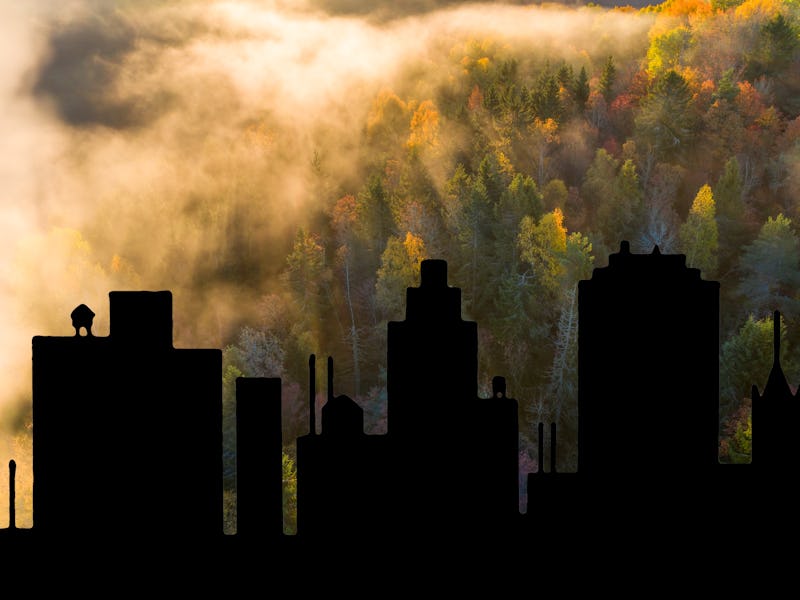Cleaning up air pollution may have a surprisingly low-tech fix
Restoring natural areas could have big benefits for human health.

Dealing with the air pollution that plagues cities across the United States doesn’t necessarily require fancy, expensive technology, new research suggests. Instead it may be easier, cheaper, and more effective to simply let nature do the work.
Restoring plant life on unused land in counties across the US could suck up 27 percent more air pollution than current rates, according to a study in the journal American Chemical Society. This strategy comes with a far lower price tag than technological fixes for most regions of the country, the authors report.
“In many situations, vegetation can provide a solution for cleaning up air that’s economically more attractive, and also environmentally and socially more attractive, than technology,” lead author and Ohio State University professor Bhavik Bakshi, Ph.D., tells Inverse.
Bakshi’s team looked at sulfur dioxide, particulate matter, and nitrogen dioxide. These pollutants have been linked to high asthma rates and fertility issues in women, among other health problems.
When it comes to air pollution, urban areas may benefit the most from restoring unused land to vegetation, according to a new study.
The researchers studied individual counties across nine climatic regions in the US, measuring benefits of restoring “available” land, or places not being used for farming or buildings, to whatever was the most common type of vegetation found in the county. They also measured how ecological restoration could benefit urban versus rural populations.
In rural areas, about 19 percent of the population would benefit from restoration, compared with 74 percent in urban areas, the researchers found.
“Population density is much higher in regions where there is not as much vegetation to take up the emissions,” Bakshi says. The vast majority of people in the US — between 74 and 98 percent — live in areas where their greenery absorbs less than half of the emissions released. So there’s plenty of room for improvement.
But even in places where the amount of air pollution taken in by plants is close to the region’s total emissions, pollution still has an impact. That comes down to the time delay between emissions entering the atmosphere and being absorbed by vegetation.
"Vegetation is not going to be able to eliminate pollution, but it can be a part of the solution.
Bakshi compares it to filling a bathtub. As you pour water into the tub, you can start to bail it out. But lowering the water’s volume doesn’t change its initial impacts.
“Just because you’re removing water from it doesn’t mean that the bathtub will not get wet at all,” Bakshi says.
The findings suggest that they key is to use both technology and ecosystem restoration to combat air pollution at the source, coming up with “a proper combination of the two.”
Policies to reduce air pollution in the US have generally focused on technology, but they can only take us so far, Bakshi says
“Vegetation is not going to be able to eliminate pollution, but it can be a part of the solution,” he says. “It needs to be basically integrated with technology.”
The benefits of restoring natural areas may extend beyond the scope of the study, according to the researchers. Cleaner air means reduced respiratory health problems, better visibility, and “other recreational benefits which are currently underestimated in this study,” they write.
Recognizing the wider benefits of healthy ecosystems for humans can help improve upon the successful engineering and policy efforts of the past, Bakshi says.
“The paradigm needs to shift towards including specifically what ecosystems are doing for us.”
Abstract: Despite the proliferation of control technologies, air pollution remains a major concern across the United States, suggesting the need for a paradigm shift in methods for mitigating emissions. Based on data about annual emissions in U.S. counties and current land cover, we show that existing forest, grassland, and shrubland vegetation take up a significant portion of current U.S. emissions. Restoring land cover, where possible, to county-level average canopy cover can further remove pollution of SO2, PM10, PM2.5, and NO2 by an average of 27% through interception of particulate matter and absorption of gaseous pollutants. We find such nature-based solutions to be cheaper than technology for several National Emission Inventory sectors. Our results with and without monetary valuation of ecological cobenefits identify sectors and counties that are most economically attractive for nature-based solutions as compared to the use of pollution control technologies. We also estimate the sizes of urban and rural populations that would benefit from this novel ecosystem-based approach. This suggests that even though vegetation cannot fully negate the impact of emissions at all times, policies encouraging ecosystems as control measures in addition to technological solutions may promote large investments in ecological restoration and provide several societal benefits.